

Douglas E Rice, Small Business Storyteller. Is There a Digital Divide or an Intellectual-Pedagogical One? What Multitasking Does To Our Brains. 10 Creative Collaboration Tips for Educators. Posted on Friday June 22, 2012 by Michael Keathley One of the most common laments that educators have is that our profession tends to isolate us from our peers.
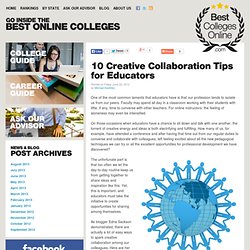
Faculty may spend all day in a classroom working with their students with little, if any, time to converse with other teachers. For online instructors, the feeling of aloneness may even be intensified. On those occasions when educators have a chance to sit down and talk with one another, the torrent of creative energy and ideas is both electrifying and fulfilling. How many of us, for example, have attended a conference and after having that time out from our regular duties to converse and collaborate with colleagues, left feeling excited about all the new pedagogical techniques we can try or all the excellent opportunities for professional development we have discovered? Think About It: Critical Thinking. Critical thinking has become a buzzword in education.
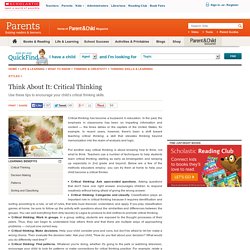
In the past, the emphasis in classrooms has been on imparting information and content — the times tables or the capitals of the United States, for example. In recent years, however, there's been a shift toward teaching critical thinking, a skill that elevates thinking beyond memorization into the realm of analysis and logic. Put another way, critical thinking is about knowing how to think, not what to think. Teachers use a number of techniques to help students learn critical thinking, starting as early as kindergarten and ramping up especially in 2nd grade and beyond. Below are a few of the methods educators employ; you can try them at home to help your child become a critical thinker. Why Every School Needs an 'Innovation Day' - Education. Google’s policy of 20 percent time—giving employees plenty of free time work on whatever they want—is world famous for being the birthplace of innovative products— most famously, Gmail.
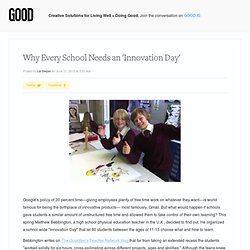
But what would happen if schools gave students a similar amount of unstructured free time and allowed them to take control of their own learning? This spring Matthew Bebbington, a high school physical education teacher in the U.K., decided to find out. He organized a school-wide "Innovation Day" that let 80 students between the ages of 11-15 choose what and how to learn. Bebbington writes on The Guardian’s Teacher Network blog that far from taking an extended recess the students "worked solidly for six hours, cross-pollinating across different projects, ages and abilities. " As a result, they made everything from art related projects like album covers and Manga to more tech-oriented projects like a remote control car and rockets. Thinking Smarter About People Who Think Differently. Lifelong UNlearning. Are you an "unlearner?

" If not, you need to become one—fast. Of the many important messages articulated by Duke professor Cathy Davidson in her newest book Now You See It: How the Brain Science of Attention Will Transform the Way We Live, Work, and Learn, that may be the one that is most relevant for educational leaders at this moment. Tina Seelig’s Insights on Creativity. 7Share Synopsis "Interacting with the world requires creative problem solving every day. Every sentence we utter is unique. We don’t just have robotic answers (...). Our brains are creativity machines". Doublethink: The Creativity-Testing Conflict. Published Online: July 17, 2012 Published in Print: July 18, 2012, as Doublethink: Creativity, Entrepreneurship, and Standardized Tests.
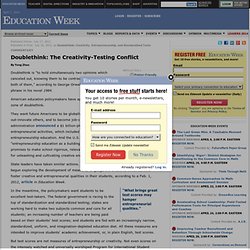
5 Ways Apple’s Culture Can Improve Your Classroom. Apple plays a critical role in education. Even without much outreach. They didn’t come to ISTE, they don’t host education conferences, but they do have a major role in both education and education technology. One Is Not Enough: Why Creative People Need Multiple Outlets - Design. I can still remember the satisfaction I took from dragging a crayon against a particularly toothy piece of paper in a coloring book when I was very young.
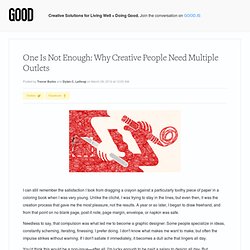
Unlike the cliché, I was trying to stay in the lines, but even then, it was the creation process that gave me the most pleasure, not the results. A year or so later, I began to draw freehand, and from that point on no blank page, post-it note, page margin, envelope, or napkin was safe. Is Productivity Killing Your Creativity?
Creativity is the Killer App (ISTE12 concurrent session) « Ed, Tech, & Biz. Introduction This afternoon I attended the ISTE12 workshop “Creativity is the Killer App” by Chris Walsh from New Tech Network (twitter: @fitzwalsh).

Here’s the short summary: This presentation will share practical examples of creativity in action and highlight high-tech and low-tech tools to leverage. It will rely heavily on design thinking principles currently in use by leading business, education, and non-profit organizations. In addition, participants will engage in series of simple activities that model design-thinking processes and instructional techniques to foster creativity, so that every participant is a step closer to implementing these ideas in their school. How Do We Teach Critical Thinking in a Connected World?
You Become What You Pretend to Be. 0Share Synopsis Your attitude influences your behavior, and, conversely, your behavior influences your attitude.

Our attitudes influence our behavior. Stop Coercing Effort and Creativity From Kids. May 1221 The time has come for us to stop grading “effort” and “creativity”.
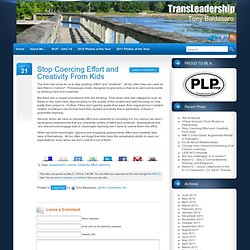
All too often they are used as lazy fillers in rubrics? Throwaways really, designed to give kids a chance to earn some points by working hard and creatively. But there are a couple of problems with this thinking. First, when kids see categories such as these on the rubric they stop focusing on the quality of the content and start focusing on how pretty their project is. Learning to 'Think Wrong' Could Be the Key to the Right Answers - Education.
Are We Wringing the Creativity Out of Kids? Killing Creativity: Why Kids Draw Pictures of Monsters & Adults Don't. What's the Big Idea?
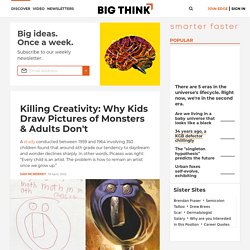
How Do You Create A Culture Of Innovation?
What Kids Should Know About Their Own Brains. Getty Neuroscience may seem like an advanced subject of study, perhaps best reserved for college or even graduate school. Two researchers from Temple University in Philadelphia propose that it be taught earlier, however—much earlier. As in first grade. In a study published in this month’s issue of the journal Early Education and Development, psychologists Peter Marshall and Christina Comalli began by surveying children aged four to 13 to discover what they already knew about the brain. Flow – A Measure of Student Engagement. Permission to Play Please - The Power of Play in All Our Lives.
When we treat play as seriously as it deserves, we feel the joy that’s in the creative spirit. 12 Most Striking Tendencies of Creative People. Kyle Wood: Channel Inspiration- think... How I Learned to Be Creative - Lifestyle. What Does Teaching Creativity Look Like? - Education. Do you see yourself as a creative person? Our current standardized approach to teaching and learning tends to slot students students into silos—art-school types on one side and analytical thinkers on the fast track to law school on the other—so our society has a pretty limited understanding of what being creative actually means and what it looks like across disciplines. Unleashing Creativity.